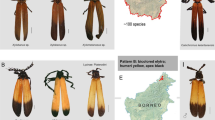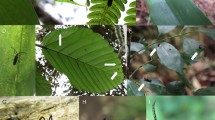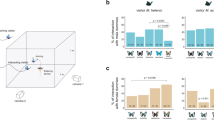Abstract
In 1879, Müller proposed that two brightly coloured distasteful butterfly species (co-models) that share a single warning-colour pattern would benefit by spreading the selective burden of educating predators1,2,3,4,5. The mutual benefit of sharing warning signals among distasteful species, so-called müllerian mimicry, is supported by comparative evidence2,3, theoretical studies5,6 and laboratory simulations7; however, to date, this key exemplar of adaptive evolution has not been experimentally tested in the field. To measure natural selection generated by müllerian mimicry, I exploited the unusual polymorphism of Heliconius cydno (Lepidoptera: Nymphalidae)8. Here I show increased survival of H. cydno morphs that match locally abundant monomorphic co-model species. This study demonstrates müllerian mimicry in the field. It also shows that müllerian mimicry with several co-models generates geographically divergent selection, which explains the existence of polymorphism in distasteful species with warning coloration9.
This is a preview of subscription content, access via your institution
Access options
Subscribe to this journal
Receive 51 print issues and online access
$199.00 per year
only $3.90 per issue
Buy this article
- Purchase on Springer Link
- Instant access to full article PDF
Prices may be subject to local taxes which are calculated during checkout



Similar content being viewed by others
References
Müller, F. Ituna and Thyridia; a remarkable case of mimicry in butterflies. Trans. Ent. Soc. Lond. 1879, xx– xxix (1879).
Wickler, W. Mimicry in Plants and Animals (Wiedenfield and Nicolson, London, 1968).
Turner, J. R. G. Butterfly mimicry—the genetical evolution of an adaptation. Evol. Biol. 10, 163–206 (1977).
Fisher, R. A. The Genetical Theory of Natural Selection (Dover Publications, New York, 1958).
Holmgren, N. M. & Enquist, M. Dynamics of mimicry evolution. Biol. J. Linn. Soc. 66, 145– 158 (1999).
Gavrilets, S. & Hastings, A. Coevolutionary chase in two-species systems with applications to mimicry. J. Theor. Biol. 191, 415–427 (1998).
Alatalo, R. & Mappes, J. Tracking the evolution of warning signals. Nature 382, 708– 710 (1996).
Kapan, D. D. Divergent Natural Selection and Müllerian Mimicry in Polymorphic Heliconius cydno (Lepidoptera: Nymphalidae). Thesis, Univ. of British Columbia (1998).
Joron, M. & Mallet, J. L. Diversity in mimicry: paradox or paradigm. Trends Ecol. Evol. 13, 461– 466 (1998).
Benson, W. W. Natural selection for Müllerian mimicry in Heliconius erato in Costa Rica. Science 176, 936– 939 (1972).
Mallet, J. L. & Barton, N. H. Strong natural selection in a warning-colour hybrid zone. Evolution 43, 421–431 (1989).
Endler, J. A. Frequency-dependent predation, crypsis and aposematic coloration. Phil. Trans. R. Soc. Lond. B 319, 459– 472 (1988).
Gilbert, L. E. in Plant-Animal Interactions: Evolutionary Ecology in Tropical and Temperate Region (eds Lewinsohn, P. W., Wilson, T. M., Fernandes, G. & Benson, W. W.) 403–427 (John Wiley and Sons, New York, 1991).
Brower, L. P., Brower, J. V. Z. & Collins, C. T. Experimental studies of mimicry. 7. Relative palatability and Müllerian mimicry among Neotropical butterflies of the subfamily Heliconiinae. Zoologica 48, 65– 83 (1963).
Chai, P. Field observations and feeding experiments on the responses of rufous-tailed jacamars (Galbula ruficauda) to free-flying butterflies in a tropical rainforest. Biol. J. Linn. Soc. 29, 161– 189 (1986).
Brower, L. P., Cook, L. M. & Croze, H. J. Predator responses to artificial Batesian mimics released in a neotropical environment. Evolution 21 , 11–23 (1967).
Cook, L. M., Brower, L. & Alcock, P. J. An attempt to verify mimetic advantage in a neotropical environment. Evolution 23, 339– 345 (1969).
Waldbauer, G. P. & Sternburg, J. G. Saturniid moths as mimics: an alternative interpretation of attempts to demonstrate mimetic advantage in nature. Evolution 29, 650–658 (1975).
Edwards, A. W. F. Likelihood 2nd edn (Johns Hopkins Univ. Press, Baltimore, 1992).
Akaike, H. in International Symposium on Information Theory 2nd edn (eds Petran, B. N. & Csáki, F.) 267–281 (Akadémiai Kiadi, Budapest, 1973).
Lebreton, J. D., Burnham, K. P., Clobert, J. & Anderson, D. R. Modeling survival and testing biological hypotheses using marked animals: a unified approach with case studies. Ecol. Monogr. 62, 67–118 (1992).
Dunlap-Pianka, H., Boggs, C. L. & Gilbert, L. E. Ovarian dynamics in heliconiine butterflies: programmed senescence versus eternal youth. Science 197, 487–490 (1977).
Brown, K. & Benson, W. W. Adaptive polymorphism associated with multiple Müllerian mimicry in Heliconius numata (Lepid. Nymph.). Biotropica 6, 205–228 (1974).
Mallet, J. L. & Joron, M. Evolution of diversity in warning colour and mimicry: Polymorphisms, shifting balance, and speciation. Annu. Rev. Ecol. Syst. 30, 201–233 (2000).
Mallet, J. L. Mallet & Singer, M. C. Individual selection, kin selection, and the shifting balance in the evolution of warning colours: the evidence from butterflies. Biol. J. Linn. Soc. 32, 337–350 (1987).
Turner, J. R. & Mallet, J. L. Did forest islands drive the diversity of warningly coloured butterflies? Biotic drift and the shifting balance. Phil. Trans. R. Soc. Lond. B 351, 835– 845 (1996).
Mallet, J. L., McMillan,W. & Jiggins, C. in Endless Forms: Species and Speciation (eds Berlocher, S. & Howard, D.) 390–403 (Oxford Univ. Press, New York, 1998).
Mallet, J. L., Longino, J. T., Murawski, D., Murawski, A. & Gamboa, A. S. Handling effects in Heliconius : Where do all the butterflies go? J. Anim. Ecol. 56, 377–386 (1987).
Skalski, J. R., Hoffman, A. & Smith, S. G. in Marked Individuals in the Study of Bird Populations (eds Lebreton, J. D. & North, P. M.) 9–28 (Birkhauser, Basel, 1993).
Mallet, J. L. et al. Estimates of selection and gene flow from measures of cline width and linkage disequilibrium in Heliconius hybrid zones. Genetics 124, 921 –936 ( 1990).
Acknowledgements
I thank D. Schluter, L. Gilbert, M. Kirkpatrick, M. Singer, R. Dudley, U. Mueller, P. Schappert, W. O. McMillan and S. Bennett for valuable discussion and critical review of this manuscript, and H. Knechtel, C. Chapman, J. Page, S. Zaklan and K. Holston for field assistance. This research is supported by Earthwatch and its volunteer corps, by L. Gilbert and, in part, by a National Science and Engineering Research Council grant to D. Schluter.
Author information
Authors and Affiliations
Corresponding author
Additional information
Centre for Biodiversity Research, Department of Zoology, University of British Colombia, Vancouver, BC, V6T 1Z4, Canada, and Section of Integrative Biology, Patterson Laboratories, University of Texas, Austin, Texas 78712-1064, USA
Rights and permissions
About this article
Cite this article
Kapan, D. Three-butterfly system provides a field test of müllerian mimicry . Nature 409, 338–340 (2001). https://doi.org/10.1038/35053066
Received:
Accepted:
Issue Date:
DOI: https://doi.org/10.1038/35053066
This article is cited by
-
Habitat generalist species constrain the diversity of mimicry rings in heterogeneous habitats
Scientific Reports (2021)
-
The genomics of coloration provides insights into adaptive evolution
Nature Reviews Genetics (2020)
-
Complex modular architecture around a simple toolkit of wing pattern genes
Nature Ecology & Evolution (2017)
-
Conservatism and novelty in the genetic architecture of adaptation in Heliconius butterflies
Heredity (2015)
-
The evolutionary genetics of highly divergent alleles of the mimicry locus in Papilio dardanus
BMC Evolutionary Biology (2014)
Comments
By submitting a comment you agree to abide by our Terms and Community Guidelines. If you find something abusive or that does not comply with our terms or guidelines please flag it as inappropriate.



